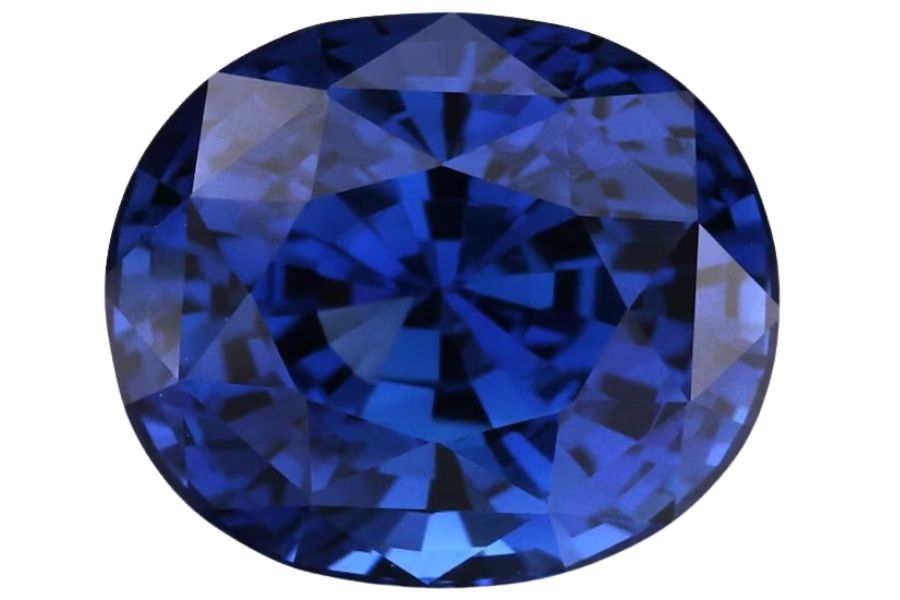Blue rocks, minerals, and gems have captivated people’s imaginations for generations, from precious stones like sapphires and blue topaz to more common blue minerals like azurite and sodalite.
These minerals have been used in a variety of ways throughout history. For example, ancient azurite was used as a pigment in paint and dyes. Sapphire, meanwhile, is one of the most sought-after stones today.
We’ll be delving into the world of blue rocks, exploring their properties, uses, and history. We’ll also be discussing some of the most well-known blue gemstones and minerals and their unique characteristics.
Blue Gems and Crystals
Here are some of the world’s most stunning and fascinating blue gems that you can find:
Amazonite – KAlSi₃O₈
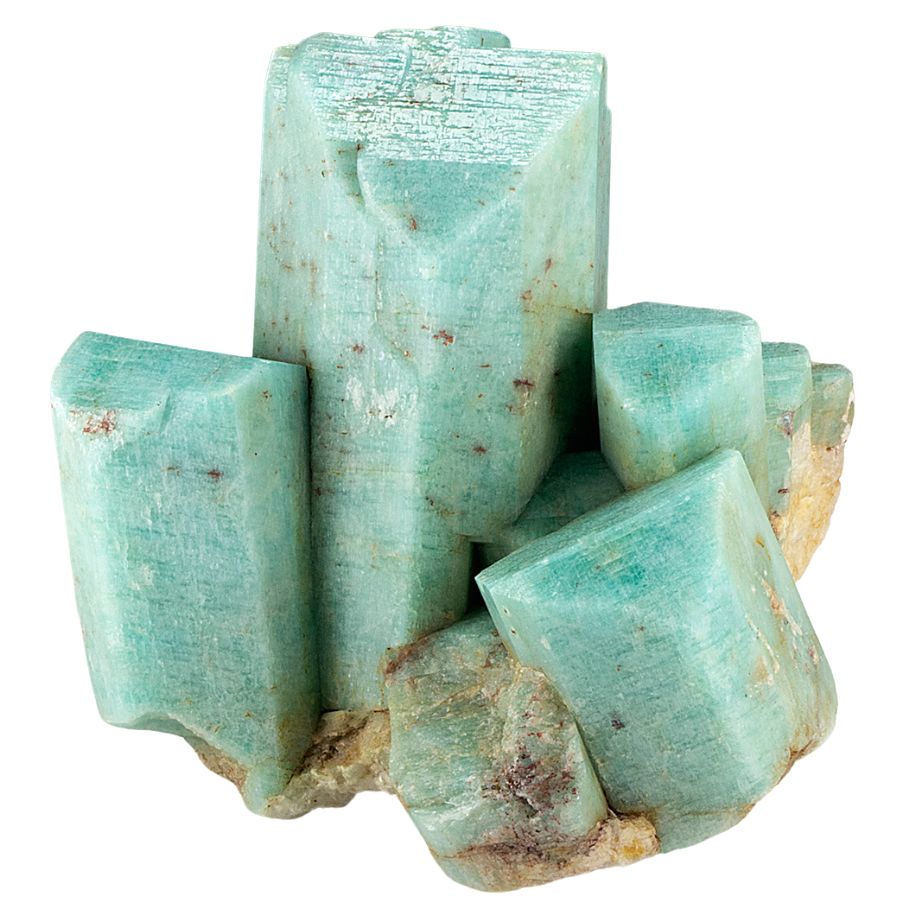
Amazonite is a beautiful, semi-precious stone that has been prized since ancient times. It was first discovered in the Amazon River basin, hence its name.
Its presence in Ancient Egypt and Mesopotamia provides evidence of its long-standing use as an amulet or talisman for protection against negative energy.
Today, Amazonite continues to be popular in jewelry pieces such as rings, necklaces, and pendants. It’s also used for decorative purposes such as carvings and sculptures. Its striking beauty makes it a beloved choice for many artisans.
Fun Fact
Amazonite is often called the Stone of Courage and the Stone of Truth, believed to help its wearer communicate their thoughts and feelings with clarity, confidence, and understanding. Where amazonite is found
Amazonite can be found in many places worldwide, including Brazil, India, Russia, Madagascar, and the United States. It’s typically mined from igneous and metamorphic rocks.
How you can identify amazonite
Color
The color of amazonite can vary from pale green to deep teal and is often mottled or streaked with white. This mineral typically exhibits a uniform color throughout, contributing to its clean and clear appearance.
Additionally, amazonite is pleochroic, meaning it can display different colors from different angles.
Hardness
Amazonite has a hardness rating of 6 on the Mohs scale. It’s considered to be a reasonably durable mineral and can withstand scratching and wear.
Clarity
Amazonite is generally opaque, but it may exhibit a slight translucency on thin edges, allowing light to pass through and enhance its color.
Refractive index
Amazonite has a refractive index of 1.524 – 1.527, depending on the angle of light. Its birefringence is 0.003, and it has double refraction.
Specific gravity
Amazonite has a specific gravity typically ranging between 2.56 and 2.58. This characteristic specific gravity contributes to the stone’s substantial feel and weight, enhancing its appeal in jewelry and decorative objects.
Aquamarine – (Be3Al2Si6O18 + Fe)
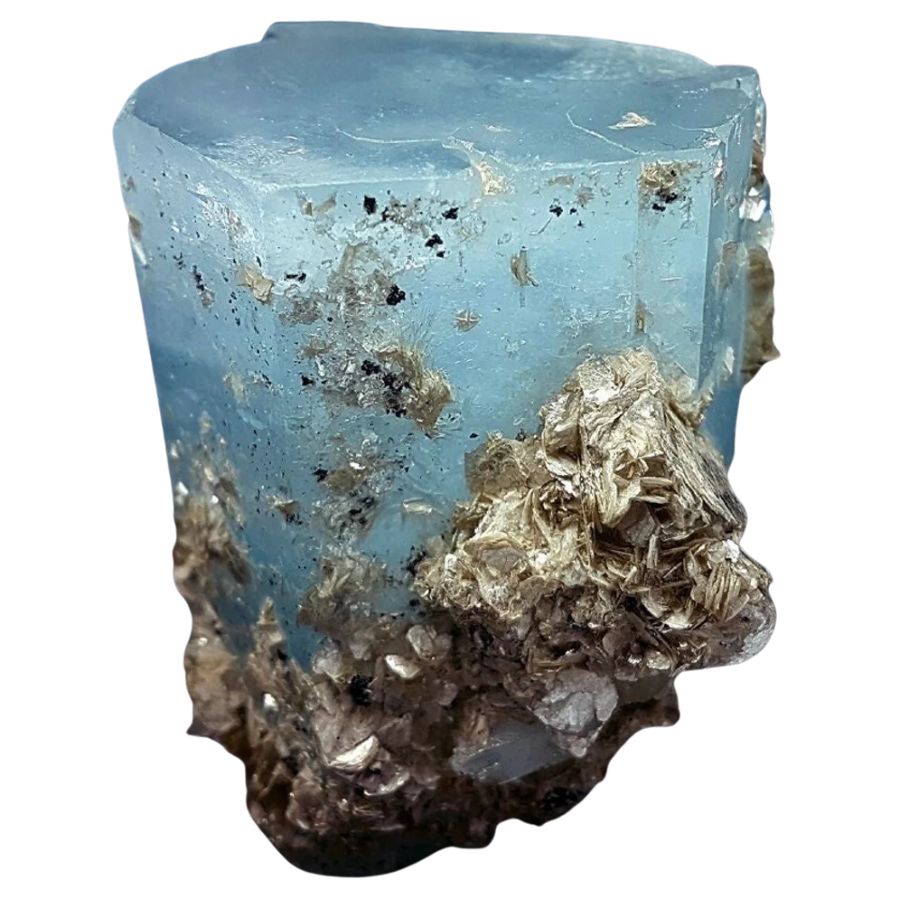
Aquamarine, a gemstone known for its range of blue colors, is part of the beryl mineral family. Its name, derived from the Latin words “aqua” meaning water and “marina” meaning sea, reflects its ocean-like tones.
The gem’s color can vary from a light, almost transparent blue to more intense teal shades, with the most prized specimens boasting a deep, vivid blue. Iron impurities within the crystal structure are responsible for its distinctive coloration.
Cutting and clarity enhancement techniques can bring out the best in aquamarine’s color and clarity, enhancing its natural beauty.
Fun Fact Aquamarine is the birthstone for March and is believed to symbolize youth, health, and hope. It's also said to bring peace and tranquility to relationships. You can also give an aquamarine as a gift to your spouse on your 19th wedding anniversary!
Where aquamarine is found
Aquamarine is mainly found in Brazil, Madagascar, Zambia, and Mozambique. But it’s also been found in other places like Russia, Nigeria, and Pakistan.
They can also be found in the US, but those are rarer.
The largest deposits are in Minas Gerais, Brazil, but the highest quality stones come from Maraba.
How you can identify aquamarine
Color
Aquamarine is celebrated for its exquisite range of blue hues, from the palest, almost clear sky blue to deeper greenish-blue shades.
Hardness
Aquamarine has a hardness of 7.5-8 on the Mohs scale of mineral hardness. This makes it a durable gemstone suitable for use in jewelry.
It’s a bit softer than other popular gemstones like diamonds and sapphires, but it’s still relatively hard and resistant to scratches and chips.
Clarity
Aquamarine is well-known for its exceptional clarity, with many stones displaying near-flawless transparency. This characteristic allows for light to pass through unimpeded, making it a favored choice for high-quality jewelry.
Refractive index
Aquamarine has a refractive index of 1.57-1.58, similar to other beryl gemstones like emerald and morganite. This high refractive index contributes to the gem’s brilliance and sparkle.
Specific gravity
The specific gravity of aquamarine is approximately 2.68-2.75, which is relatively heavy for a gemstone. This density makes aquamarine a durable material that can withstand the wear and tear of everyday use in jewelry.
Chalcedony – SiO₂
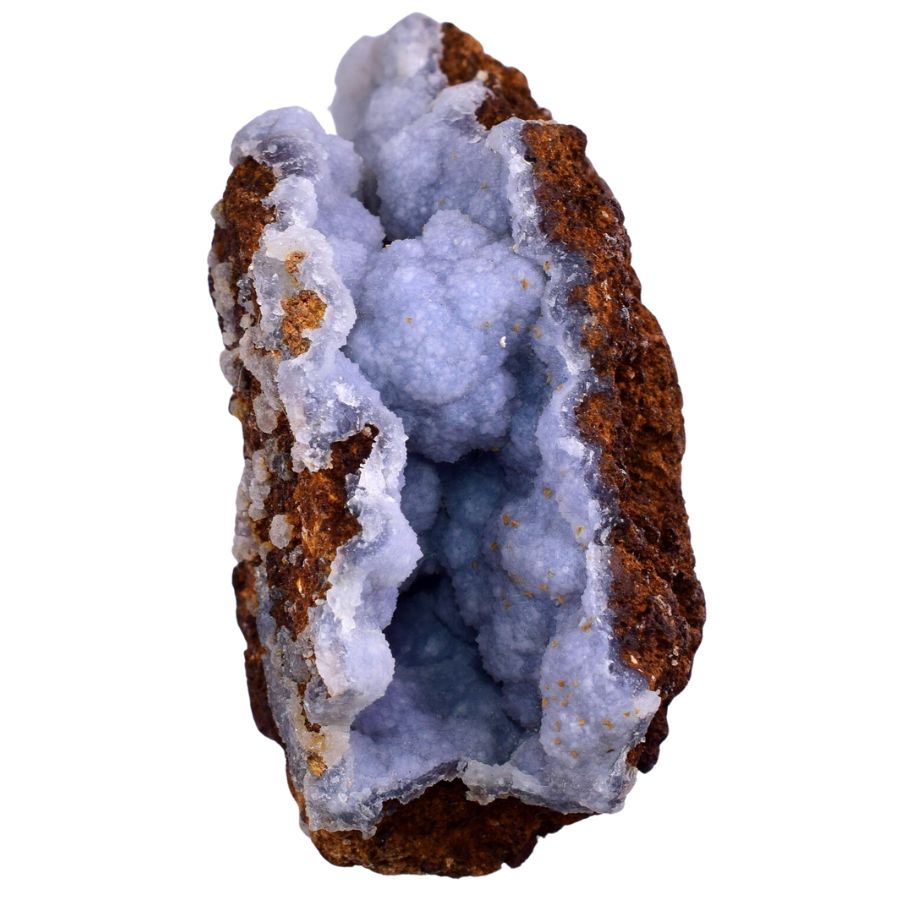
Chalcedony is a form of silica composed of fine intergrowths of quartz and moganite, known for its waxy luster and wide range of colors, including white, blue, gray, and a variety of other shades.
It’s actually a broad term that encompasses many well-known varieties of cryptocrystalline quartz, such as agate, jasper, onyx, and carnelian.
Also, it’s typically opaque or semi-translucent and has a smooth, almost creamy texture that has made it popular in jewelry and carving for centuries.
Its durability and malleability have made it a favorite medium for artisans and sculptors, shaping it into everything from beads to intricate cameos and decorative items.
Fun Fact
Did you know that the name "chalcedony" is derived from the ancient Greek city of Chalcedon, which was a hub of trade for the stone in ancient times?
Chalcedony was highly valued in ancient civilizations, such as Greece and Rome, and was believed to have mystical properties that could ward off evil spirits and promote good luck.Where chalcedony is found
Chalcedony is found worldwide, including in the USA, Australia, Brazil, China, and Madagascar. They’re primarily found in volcanic and sedimentary rocks.
How you can identify chalcedony
Color
Chalcedony is a semi-precious stone with a mesmerizing blue hue. Its color ranges from pale to deep blue and is often characterized by white or grey streaks.
Hardness
Chalcedony has a hardness of 7 on the Mohs scale. It’s not as hard as diamonds, which have a hardness of 10, but it’s still quite durable and difficult to scratch.
Clarity
Chalcedony typically exhibits a waxy to dull luster and is often translucent to opaque. Its fine microcrystalline structure diffuses light, giving it a characteristic glow that is prized in jewelry and decorative objects.
Refractive index
Chalcedony’s refractive index is typically between 1.45 and 1.54, which is relatively high compared to other gemstones.
It has a low birefringence value and a low dispersion, meaning it does not produce rainbows or fire when light passes through it like some other gemstones.
Specific gravity
Chalcedony has a specific gravity of 2.6-2.7, slightly higher than the average gemstone. It’s a bit heavier than most gemstones but is light enough to comfortably wear as jewelry.
Celestite – SrSO4
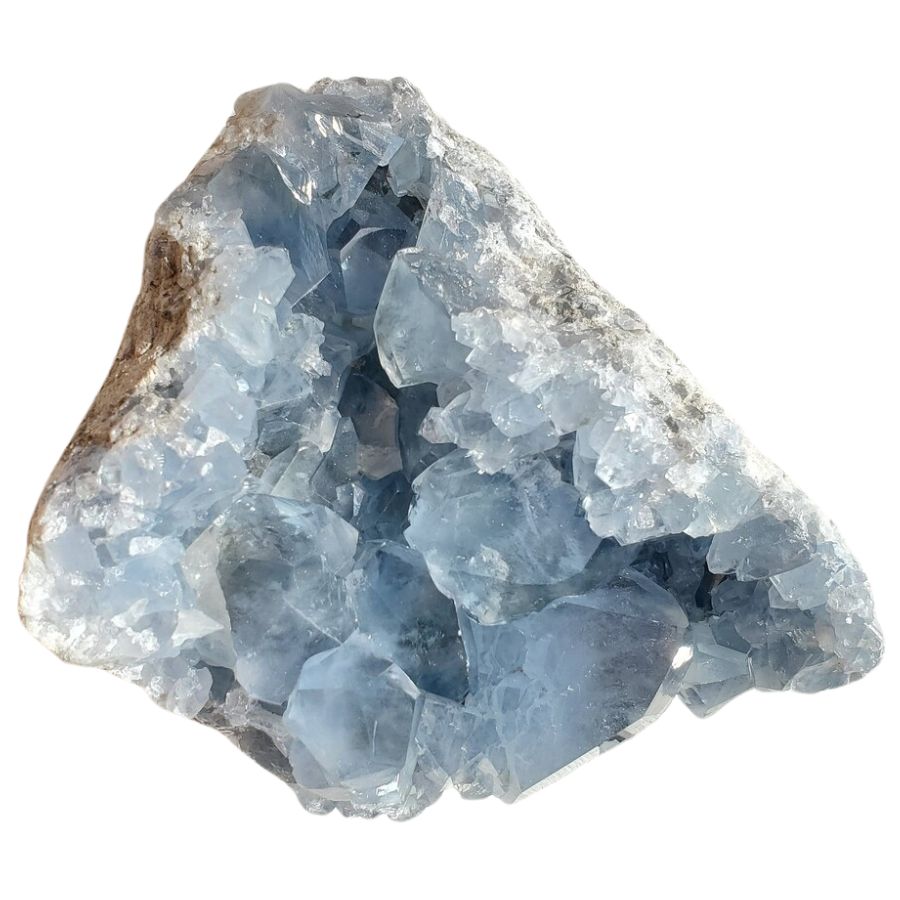
Celestite, also known as celestine, is a mineral known for its delicate blue color. It can range from pale, sky-blue shades to more intense azure hues, reminiscent of the clear daytime sky.
It’s primarily composed of strontium sulfate and often forms in well-defined, tabular crystals that can be quite striking in appearance.
Celestite has a vitreous luster that gives it a pearly sheen, enhancing its soft blue glow and making it a favorite among collectors and enthusiasts for decorative use.
In the early 19th century, it was discovered that celestite could be used as an ore for strontium production, which increased its popularity and mining throughout Europe and North America.
Fun Fact With crystals measuring up to 35 feet tall and 3 feet wide, celestite holds the record for the largest geode in the world ever discovered. Talk about heavenly!
Where celestite is found
Celestite can be found in specific locations worldwide, particularly in Europe and North America. It’s also been reported to be found in South Africa, India, Mexico, Morocco, Algeria, Canada, Germany, England, and Russia.
Some of the most common places to find celestite are sedimentary rocks, evaporite deposits, hot springs, and geysers.
How you can identify celestite
Color
Celestite is most renowned for its delicate, pale blue color, which can vary from soft, sky-like hues to deeper azure shades. This gentle and appealing color is a defining characteristic that makes celestite a sought-after mineral.
Hardness
Celestite is a relatively soft mineral with a hardness ranging from 3 to 3.5 on the Mohs scale. It’s easily scratched with a fingernail or other everyday objects and can be cut with a knife or chisel.
Clarity
Celestite is typically transparent to translucent, with a vitreous luster. The clarity of celestite varies depending on the size and shape of the crystals; larger crystals tend to be more transparent than smaller ones.
Refractive index
Celestite has a refractive index of approximately 1.48 to 1.49, which is relatively low compared to other minerals such as diamond and quartz.
It’s a birefringent mineral, meaning that when light passes through it, the speed of light changes depending on the direction it’s traveling in.
Specific gravity
The specific gravity of celestite ranges from 2.9 to 3.2, depending on the origin and purity of the sample. This is relatively high compared to other minerals, indicating that celestite is dense.
Kyanite – Al₂SiO₅
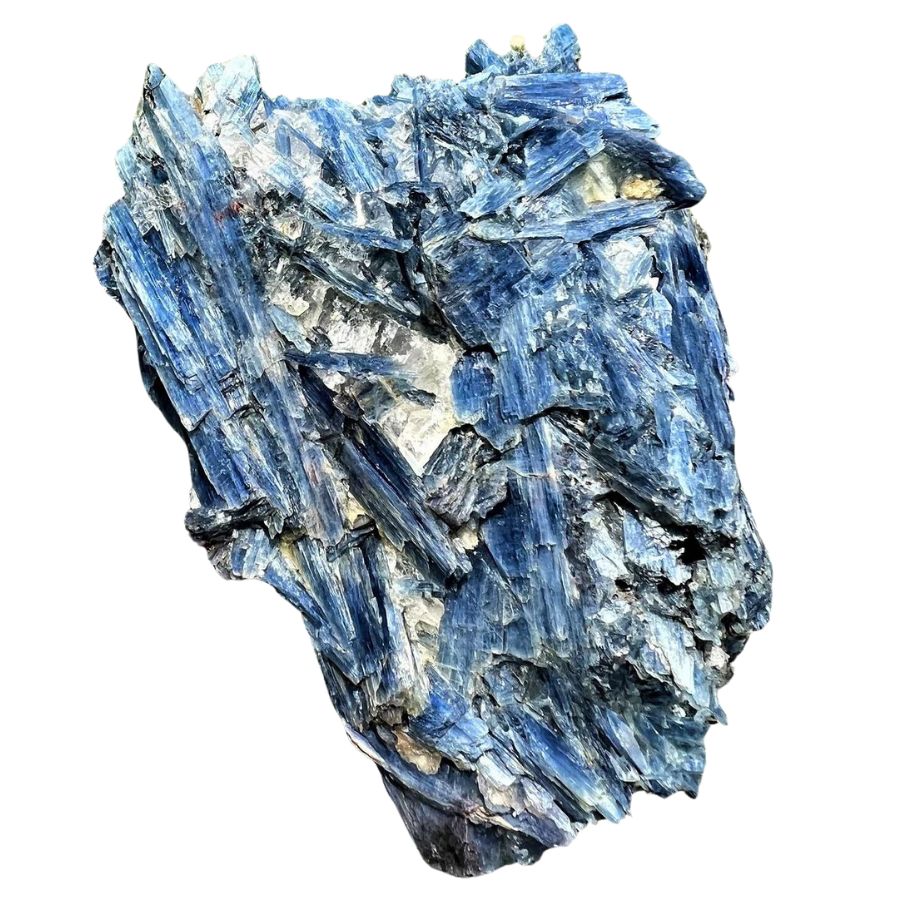
Kyanite is a cool mineral that comes in beautiful blues and sometimes greens, blacks, or even colorless. It looks like long, flat blades and feels kind of like a stack of books with its layers.
One neat thing about kyanite is that it’s used in making things that have to stand up to really high temperatures, like in electronics and spark plugs.
This is because kyanite doesn’t melt easily and can handle the heat. It’s also used in porcelain bathroom fixtures and dishes because it’s strong and helps them hold up over time.
Fun Fact
Kyanite is a fragile stone that cannot be left submersed in water as it will dissolve.Where kyanite is found
Kyanite is found in metamorphic rocks worldwide, with notable deposits in Brazil, Austria, Switzerland, India, Kenya, and the United States.
How you can identify kyanite
Color
Kyanite is typically a blue-gray color, with some variations ranging from white to black. It can also come in shades of green, yellow, orange and pink.
Hardness
Kyanite is a generally soft mineral, typically measuring between 4 and 5.5 on the Mohs scale of mineral hardness. It’s hard enough to scratch glass but softer than most other gemstones, such as quartz or diamond.
Its hardness can vary depending on the direction in which it’s cut, with its hardness increasing with the angle of the cut.
Clarity
Kyanite’s clarity can vary from transparent to translucent, depending on the number of inclusions present. It can also have a pearly or silky luster in some cases. Kyanite is often cut into cabochons to show off its clarity and enhance its beauty.
Refractive index
Kyanite has a refractive index that ranges from 1.717-1.739 for the ordinary ray and 1.739-1.759 for the extraordinary ray. It’s birefringent, meaning it has two different refractive indices depending on the direction of light passing through the gemstone.
Kyanite also exhibits pleochroism, meaning it can display different colors when viewed from different angles due to its double refraction.
Specific gravity
The specific gravity of kyanite ranges from 2.7 to 3.5 depending on the composition and density of the mineral. The higher the specific gravity, the denser the mineral.
Kyanite is a relatively lightweight mineral, so its specific gravity is generally lower than other minerals such as quartz or feldspar.
Labradorite – (Na,Ca)₁₋₂Si₃₋₂ O₈
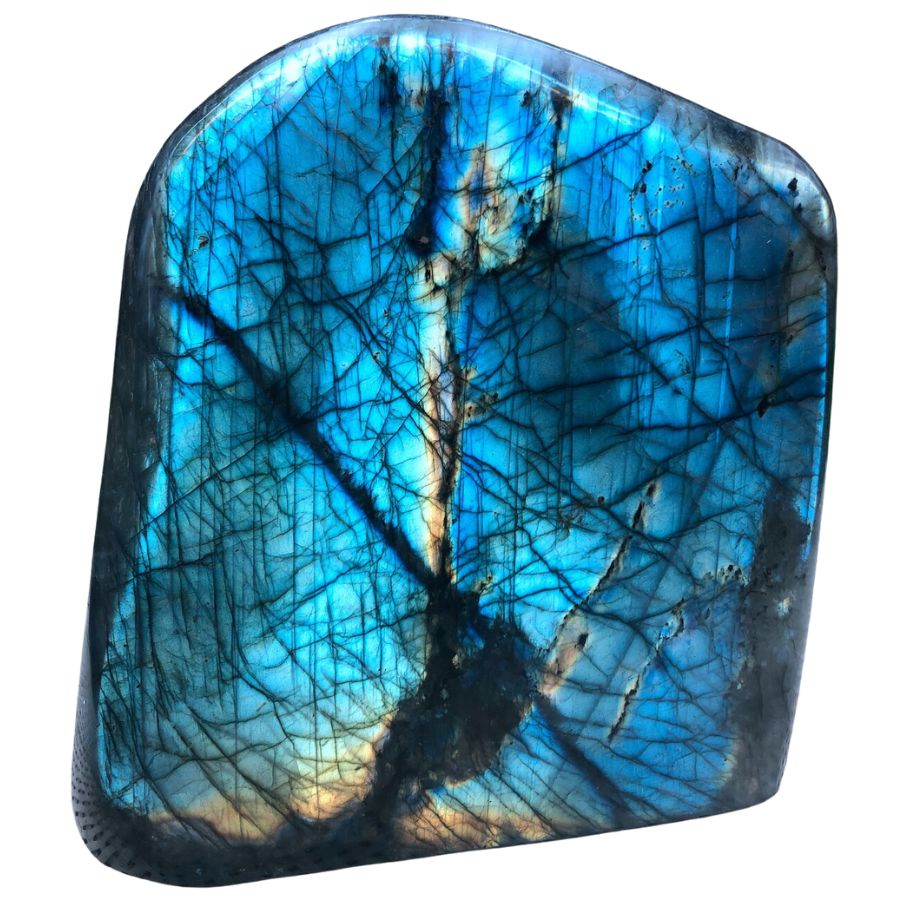
Labradorite is a really neat rock that usually looks blue but can also shine with yellows, greens, and oranges when it catches the light just right. This cool effect is called labradorescence, and it makes each piece of labradorite unique and special.
People like to use labradorite for countertops and tiles because it’s pretty strong and looks great when polished. It’s also popular in jewelry, shining with all its different colors when it moves.
The shifting colors of labradorite make each piece unique, catching eyes with its unexpected flashes. It’s not just pretty; labradorite is used in glass making too, because it helps the glass be tougher and more resistant to scratches.
Fun Fact Did you know that the optical effect that labradorite exhibits is known as labradorescence? It means that it has an iridiscent optical effect and it was Ove Balthasar Bøggild who first used the term.
Where labradorite is found
Labradorite is found in Canada, specifically in Labrador, as well as in Finland, Norway, Sweden, and Madagascar.
How you can identify labradorite
Color
Labradorite is a complex, iridescent stone that displays various colors, including blue, green, yellow, orange, red, and purple. Its unique color play is created by light reflecting off the different layers of feldspar within the stone.
Hardness
Labradorite is a mineral with a hardness of 6 to 6.5 on the Mohs scale. It’s relatively complex and challenging, making it difficult to break or scratch. Its hardness makes it an ideal material for jewelry and other decorative items.
Clarity
Labradorite typically exhibits a translucent to opaque clarity, which allows for its labradorescence to shine through.
Refractive index
Labradorite has a refractive index of 1.559 to 1.586, depending on the angle of incidence and polarization of light, making it an anisotropic mineral.
Its birefringence is 0.027, which indicates that it’s doubly refractive and can split a beam of light into two rays with different polarizations when passed through the stone.
Specific gravity
Labradorite has a specific gravity of 2.7 to 2.9, slightly higher than the average for minerals. This is due to its relatively high density, caused by its composition of silicate and other inorganic compounds.
Sapphire – Al₂O₃
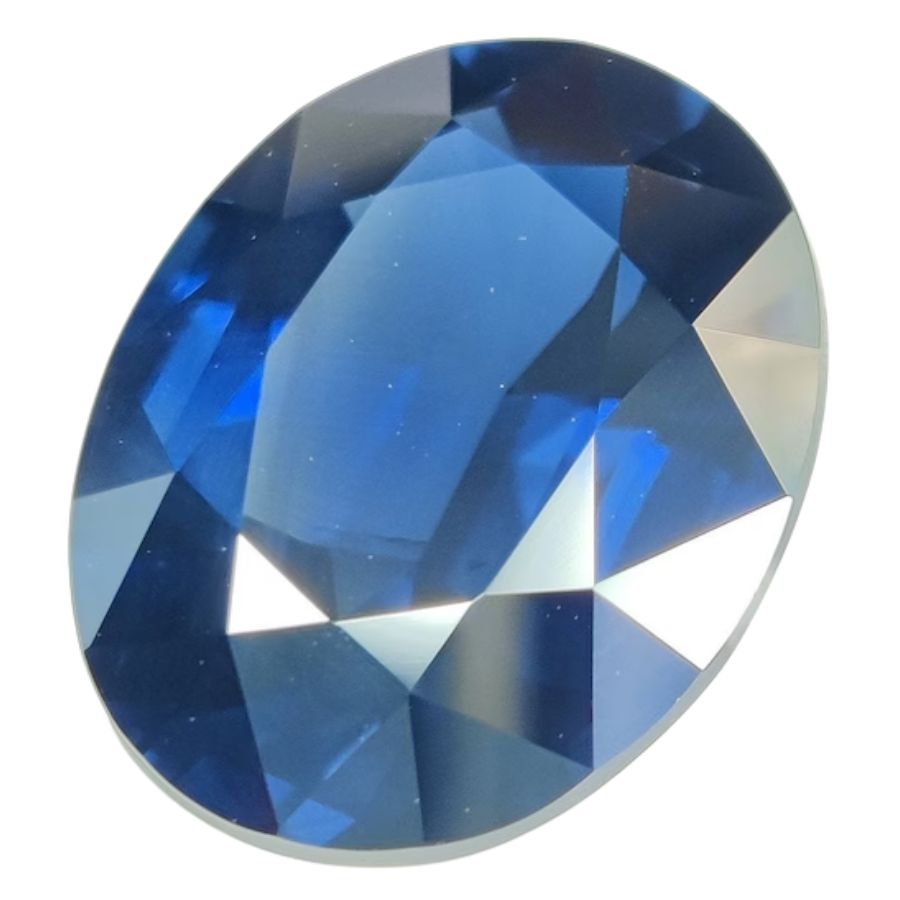
Sapphire is a super cool gemstone that’s most famous for its bright blue color, but it can actually come in a bunch of other colors too, like pink, yellow, and even clear.
It’s really strong, so it’s not just used in pretty jewelry like rings and necklaces, but also in practical things like watches and scientific instruments.
The different colors of sapphire are used to make windows for aircraft and spacecraft because they’re really tough and can handle a lot of wear and tear.
Sapphires are also great for lasers and electronic wafers due to their ability to withstand extreme conditions.
Even though they’re known for their beauty, sapphires are super useful in many different industries because of how strong and versatile they are.
Fun Fact When sapphires are cut in a cabochon form, a special phenomena known as asterism can happen. A "star sapphire" is a type of inclusion in the stone that produces a star-like pattern of rays on the surface.
Where sapphire is found
Sapphires can be found in many locations across the globe, including India, Sri Lanka, Thailand, Cambodia, Australia, Brazil, Madagascar, Tanzania, and the United States (Montana).
Confusing sapphire with other rocks and minerals is a common mistake, but we’re here to help you avoid it. Look at our informative guides below to ensure that what you have is truly sapphire.
How you can identify sapphire
Color
Sapphire is a rich blue hue, often described as a deep, intense shade. It’s prized for its striking and vibrant appearance.
Hardness
Sapphire is a hard mineral with a Mohs hardness of 9. The hardness of Sapphire makes it an ideal choice for use in jewelry and other items that will be subject to wear and tear, as it’s resistant to scratches and other forms of damage.
Additionally, its hardness means that it will retain its color and luster over time, making it a popular choice for high-end jewelry and other luxury items.
Clarity
Sapphire is known for its exceptional clarity, ranging from transparent to slightly translucent, allowing light to pass through and showcase its vibrant colors.
This clear quality makes it a prized gem in jewelry, as it sparkles brilliantly when cut and polished, highlighting its depth and richness of color.
Refractive index
Sapphire has a refractive index of 1.76, which means it bends light more than many other minerals and materials.
The high refractive index of sapphire gives it a bright, sparkling appearance, as light is internally reflected multiple times before it leaves the stone.
Specific gravity
Sapphire has a specific gravity of 4.0, which is relatively high compared to many other minerals and materials. The high specific gravity of sapphire makes it heavier than many other minerals of similar size and shape, giving it a substantial feel.
Tanzanite – Ca2Al3(SiO4)3(OH)
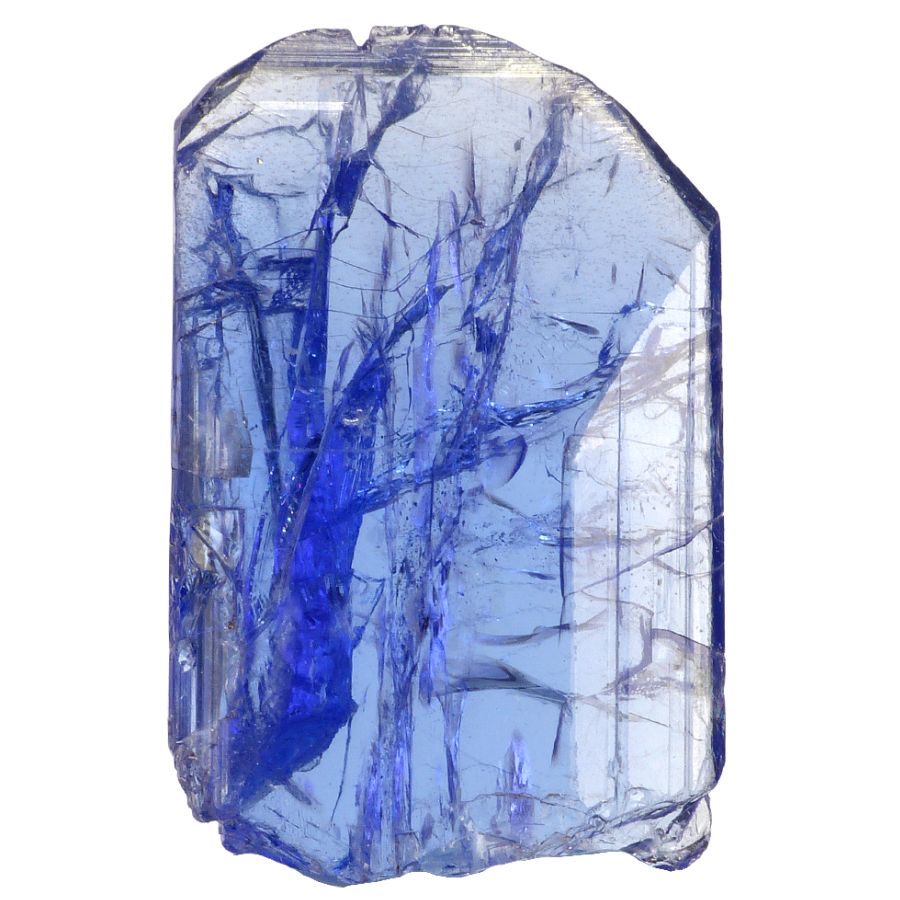
Tanzanite is a really special gemstone that’s known for its stunning deep blue color, but it can also change to violet and burgundy depending on the light.
It’s a pretty new discovery in the world of gems, making it a favorite for people who love to have something different and unique.
Most folks like to use tanzanite in jewelry, like in pretty earrings or necklaces, because it stands out with its cool colors. Even though it looks fancy, tanzanite is also tough enough to be used in different kinds of crafts and decorations.
Fun Fact It was first known as 'blue zoisite' before being renamed 'tanzanite' by Tiffany and Co. in 1968.
Where tanzanite is found
Tanzanite is most commonly found in Tanzania but can also be found in other countries such as Kenya, Ethiopia, Mozambique, and Madagascar. They can also be found in some jewelry stores across the world.
If you’re not completely certain that what you’ve discovered is tanzanite, don’t worry. Our guides are here to provide you with the knowledge and confidence to accurately identify tanzanite from other rocks and minerals.
How you can identify tanzanite
Color
Tanzanite is a captivating gemstone with a vivid blue-violet hue. It has an exquisite color that is often described as a blend of sapphire and amethyst.
It can also appear purple, blue, or red depending on the angle it’s viewed, making it a highly sought-after gemstone.
Hardness
Tanzanite is a 6.5 to 7 on the Mohs scale of hardness, making it a relatively soft gemstone. It’s slightly less hard than quartz and more durable than opal, but not as hard as sapphire or diamond.
Clarity
Tanzanite is typically known for its high clarity, with most high-quality stones being eye-clean, meaning they lack visible inclusions or flaws. This clear quality enhances its deep, vibrant color, making tanzanite a sought-after gem.
Refractive index
The refractive index of tanzanite is between 1.690 and 1.700, making it a higher refractive index than many other gemstones.
Specific gravity
The specific gravity of tanzanite is 3.35 – 3.40, considered one of the highest among all gemstones. It has a higher density than other gemstones, making it heavier for its size.
Turquoise – CuAl₆(PO₄)₄(OH)₈·4H₂O
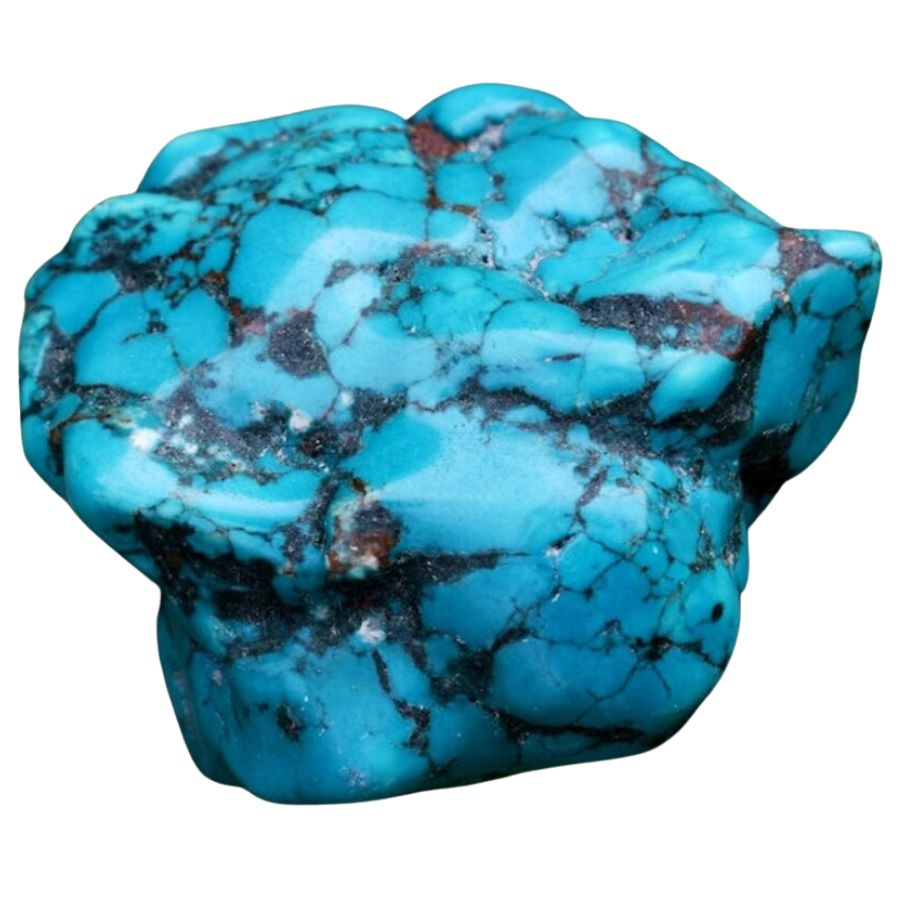
Turquoise is a cool rock that’s mostly known for its awesome bright blue color, but it can also be green or even have little lines of other colors running through it.
This rock is super popular because each piece has its own unique look, with different patterns and shades. People have used turquoise for a long time to make jewelry like necklaces and bracelets because it’s not too hard and easy to shape.
Besides jewelry, turquoise can be used to make beautiful decorations and is often seen in things like belts, furniture, and fancy dishes.
Fun Fact
Turquoise is the only gemstone that is associated with an official color named after it. Where turquoise is found
It has been found in many different parts of the world, including Egypt, Mexico, Tibet, and Persia.
How you can identify turquoise
Color
Turquoise is a refreshing and calming color. It has a blueish-green hue, often likened to the color of the sea. The shade varies from light to dark, but its most common representation is a medium blue-green.
Hardness
Turquoise is a relatively soft gemstone, with a Mohs hardness of 5-6 on the Mohs scale. It’s softer than quartz, harder than calcite, and can be scratched or chipped with a hard object such as a knife or file.
However, it’s still considered quite durable and suitable for jewelry as long as it’s protected from hard knocks and abrasive surfaces.
Clarity
Turquoise is typically opaque, meaning it doesn’t let light pass through, giving it a solid and dense appearance that’s ideal for carving and shaping.
Refractive index
Turquoise has a refractive index of 1.61-1.65, which is slightly lower than that of quartz and higher than that of feldspar.
The birefringence of turquoise is very low, typically between 0 and 0.004, meaning that it does not have double refraction like some other minerals do.
Turquoise also has a relatively high dispersion compared to other minerals, which makes it sparkle when cut into a cabochon or faceted gemstone.
Specific gravity
Turquoise has a specific gravity of 2.6 to 2.8, higher than most other blue gemstones. This means that it’s denser than most other gemstones and will be heavier when compared to a material of the same size.
The specific gravity of turquoise is also relatively consistent, making it easy for jewelers to identify this gemstone for its unique physical properties.
Blue Rocks
A few of the most intriguing blue rocks in existence are listed below:
Lapis Lazuli – (Na,Ca)₈Al₆Si₆O₂₄ (S,SO)₄
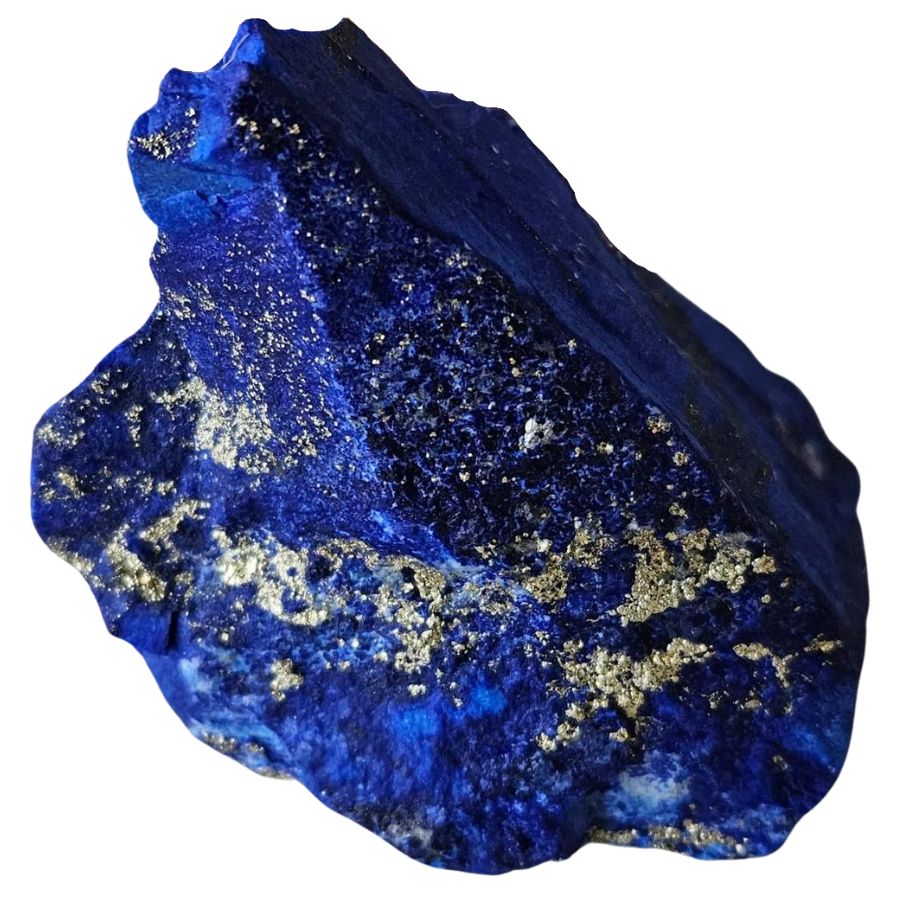
Lapis lazuli is a really neat rock that’s mostly a deep, royal blue but can sometimes have touches of white or gold colors. The gold flecks that you often see in lapis lazuli are actually tiny bits of pyrite, which is a mineral that can look like gold.
People love to use lapis lazuli in jewelry and decorative items because its bright blue color and shiny specks make it super pretty. This stone has also been ground up and used as a paint color for artists, especially famous for its intense blue shade.
Lapis lazuli isn’t just for looking at; it’s also used in making fancy tabletops, tiles, and other cool home decorations. Its unique look makes every piece of lapis lazuli special and a favorite for adding a splash of color.
Fun Fact
The blue hues in Michelangelo's frescoes for the Sistine Chapel were created with lapis lazuli powder.Where lapis lazuli is found
Lapis lazuli is mainly found in Afghanistan but can also be found in other parts of the world, such as Chile, Russia, Pakistan, Angola, and the United States.
How you can identify lapis lazuli
Color
Lapis lazuli has a deep, intense blue color with golden pyrite flecks. Its hue is vibrant yet calming, like a midnight sky filled with stars.
Hardness
Lapis lazuli is a relatively hard stone, with a rating of 5-6 on the Mohs hardness scale. This means it’s harder than glass and softer than quartz, allowing it to be carved and polished into jewelry, sculptures, and other ornamental items.
Clarity
Lapis lazuli is generally opaque, providing a dense and richly colored stone.
Refractive index
Lapis lazuli is a semi-precious blue stone whose refractive index ranges from 1.50 to 1.54. The exact value depends on the specific composition of the stone.
The refractive index of lapis lazuli also affects the optical properties and appearance of the stone, contributing to its unique blue color and luster.
Specific gravity
The specific gravity of lapis lazuli is typically between 2.7 and 2.9, which is considered a relatively high density for a gemstone. This means lapis lazuli is heavier than most other gemstones, except for some varieties of zircon and diamond.
Blue Minerals
The following is a list of some of the most remarkable blue minerals ever discovered:
Apatite – Ca5(PO4)
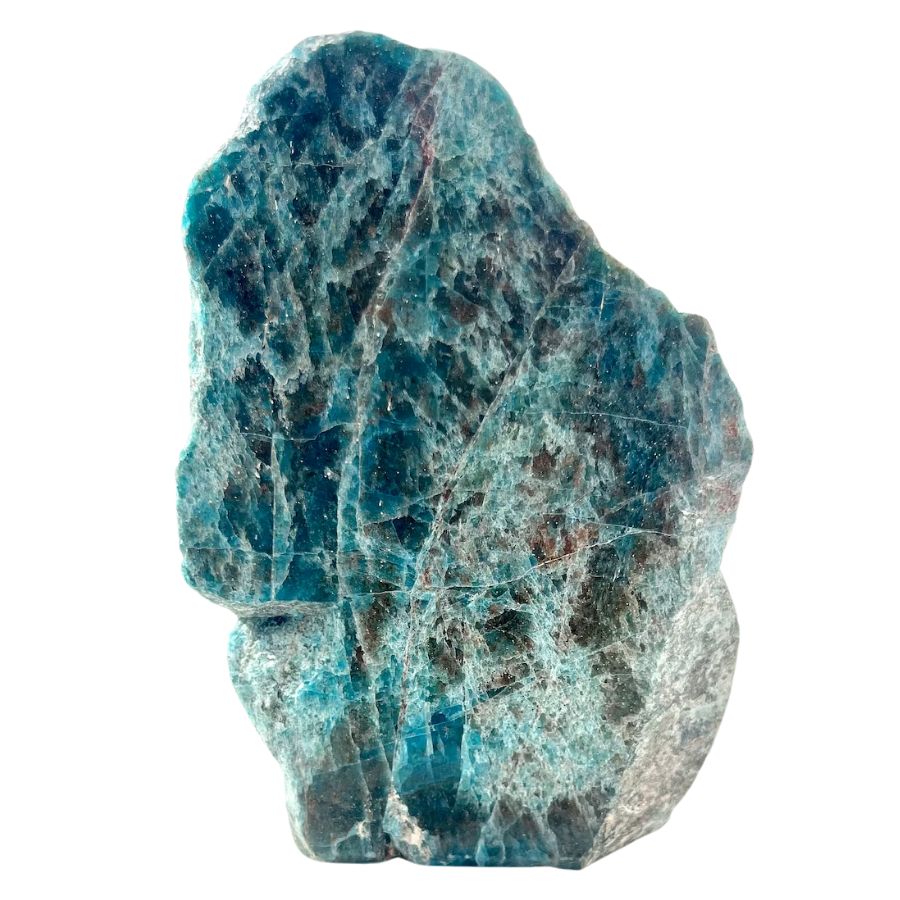
Apatite is a really interesting mineral that comes in a bunch of colors, from bright blues and greens to yellows and even purples. This colorful mineral isn’t just pretty to look at; it’s super useful in different ways.
One of the coolest things about apatite is that it’s used to make fertilizer. That’s because apatite has phosphorus, which is really important for plants to grow well.
Sometimes, apatite is used in making things that have to be really strong, like certain types of glass and even dental products.
Its wide range of colors and usefulness in everyday stuff makes apatite a standout mineral in both nature and our daily lives.
Fun Fact
Did you know that apatite can be found in your toothpaste? It's the main source of phosphorus, a nutrient essential for having healthy teeth and bones!Where apatite is found
Apatite is most commonly found in sedimentary and metamorphic rocks. It can also be found globally but is most commonly found in Africa, Canada, India, Mexico, Norway, Russia, Spain, and the United States.
How you can identify apatite
Color
Apatite is a vibrant and beautiful gemstone, often found in shades of blue, green, yellow, and purple. The most typical shade is a deep blue-green color with hints of yellow or other hues depending on the light.
Hardness
Apatite has a hardness of 5 on the Mohs scale, making it a relatively hard mineral. It’s considered to be harder than glass but softer than most metals.
It can be scratched with a knife and leave a white streak against unglazed porcelain, but it’s not as hard as quartz or topaz.
Clarity
Apatite is a transparent to translucent gemstone with a vitreous luster. It usually has good clarity, although eye-visible inclusions can occur. It can display optical phenomena such as chatoyancy, asterism, and adularescence in specific stones.
Refractive index
Apatite has a refractive index that ranges from 1.627 to 1.644, depending on the type of apatite and the angle of light refraction.
Its birefringence is low, typically between 0.009 and 0.014, and its dispersion is high at 0.029-0.081 when measured with a sodium light source at 589 nm wavelength.
Specific gravity
The specific gravity of apatite is generally around 3.1 to 3.4, which is relatively low compared to other minerals. This means that for a given volume, apatite will be lighter than most other minerals since it has a lower density.
Azurite – C2H2Cu3O8
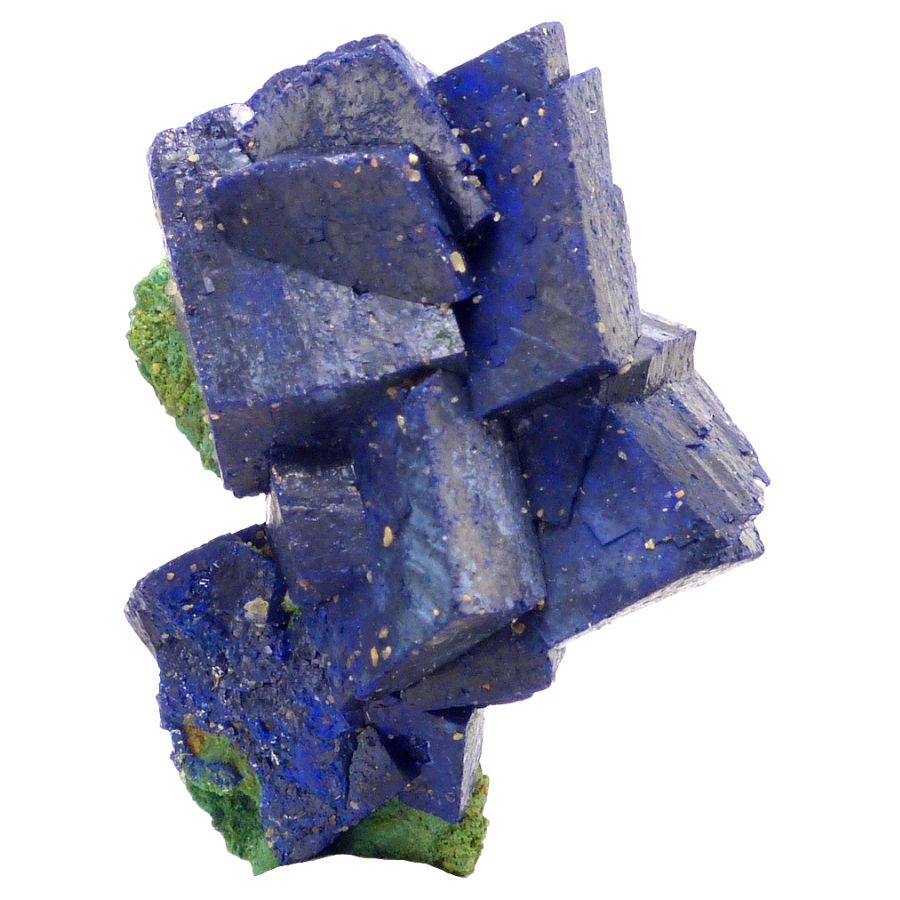
Azurite is a bright blue mineral that catches the eye with its vivid color. It’s used in jewelry and decorative pieces, adding a splash of color to anything it’s part of.
In the past, azurite was ground up and used as a blue pigment for paints, making beautiful art.
Azurite isn’t just pretty to look at. It also helps geologists understand more about the earth because it forms in copper-rich areas.
People also use azurite in educational collections to learn about different minerals and how they are part of our world.
Fun Fact
The most significant blue pigment in use during the Middle Ages and Renaissance was azurite. It slowly transforms into malachite through a process known as pseudomorphism over time.
Because of this, several paintings from these eras have turned from blue to a greenish tint.Where azurite is found
Azurite is commonly found in copper mines, particularly in the southwestern United States, Mexico, Chile, and Australia. It’s also found in sedimentary rocks, such as shale and limestone.
How you can identify azurite
Color
Azurite is a deep, vibrant blue color reminiscent of a clear summer sky. It has a strong, striking color that can range from a light, powdery blue to an intense royal blue.
Hardness
Azurite ranks at about 3.5 to 4 on the Mohs scale of hardness, meaning that it’s relatively soft compared to many other minerals. This softness means azurite needs to be handled carefully to avoid scratches or damage.
Clarity
Azurite is typically opaque, which gives it a solid and dense appearance.
Refractive index
Azurite has a refractive index of 1.71 to 1.74, slightly higher than the average refractive index of 1.5-1.7 for most gemstones. This higher refractive index gives azurite its distinctive deep blue color and sparkle.
Specific gravity
The specific gravity of azurite is 3.77 to 3.89, which is relatively high for a mineral. It has a slightly higher density than quartz, though its weight is still considered light for its size due to its porous nature.
Bornite – Cu5FeS4
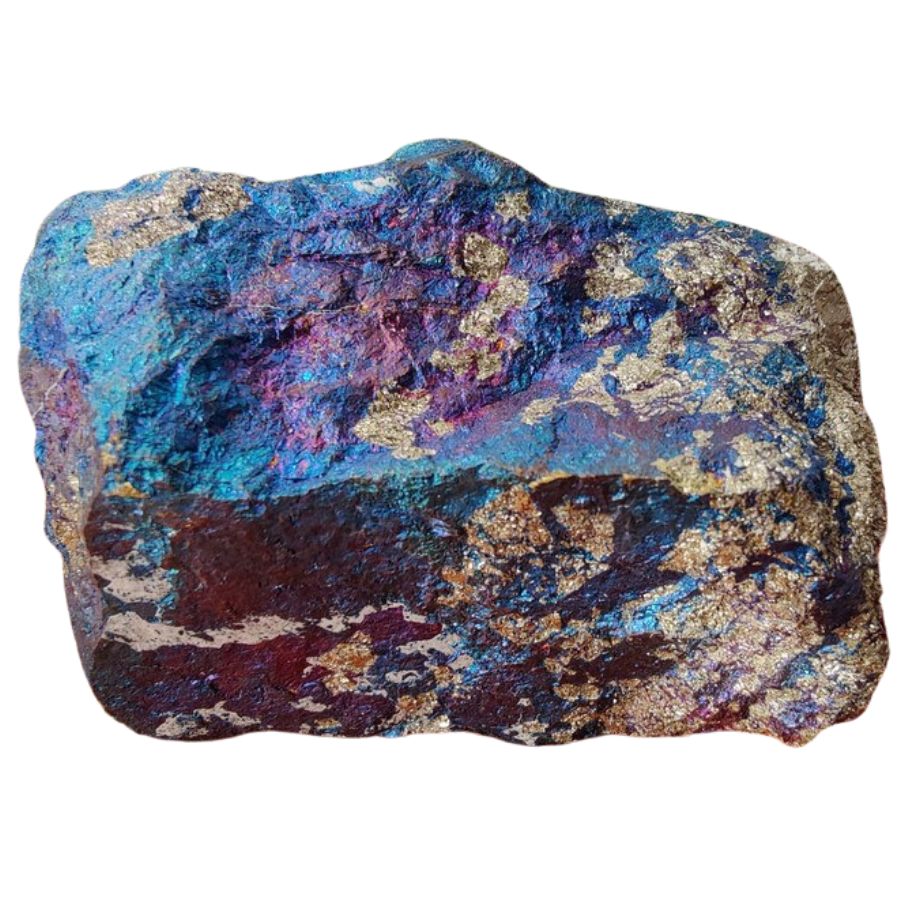
Bornite is a fascinating mineral known for its colorful appearance, often showing a mix of purple, blue, and red shades.
This mineral is primarily used in the extraction of copper, which is a valuable resource for making electrical wires and plumbing materials.
Bornite’s unique iridescent colors also make it popular among collectors and for educational purposes. Sometimes, it’s used in jewelry, giving a distinct and colorful look to various accessories.
When exposed to air, bornite undergoes a chemical change, developing a rich and colorful tarnish.
Fun Fact Bornite is an important ore of copper and is sometimes referred to as "Peacock Ore" because of its iridescent tarnish, which can range in color from a bright blue to a deeper purple, depending on the angle of light.
Where bornite is found
Bornite can be found in many parts of the world, including the United States, Canada, Australia, South Africa, and Russia. You can find bornite minerals in copper deposits as well!
How you can identify bornite
Color
Because it tarnishes to iridescent hues of blue, purple, red, green, and yellow, bornite is easily identifiable.
Hardness
Bornite is a copper iron sulfide mineral with a hardness ranging from 3 to 4 on the Mohs scale. It’s relatively brittle and can be easily scratched with a knife.
Clarity
Bornite typically has an opaque clarity, meaning it does not allow light to pass through it. This characteristic contributes to its bold and distinctive appearance, emphasizing its striking metallic luster and colorful tarnish.
Refractive index
The refractive index of bornite is somewhere between 1.75 and 2.15, depending on the sample. It’s anisotropic, meaning that light travels at different speeds depending on its direction.
Specific gravity
The specific gravity of bornite is between 3.9 and 4.2, depending on its composition. It has a higher density than most other minerals.
Chrysocolla – (Cu2-xAlx)H2-xSi2O5(OH)4·nH2O
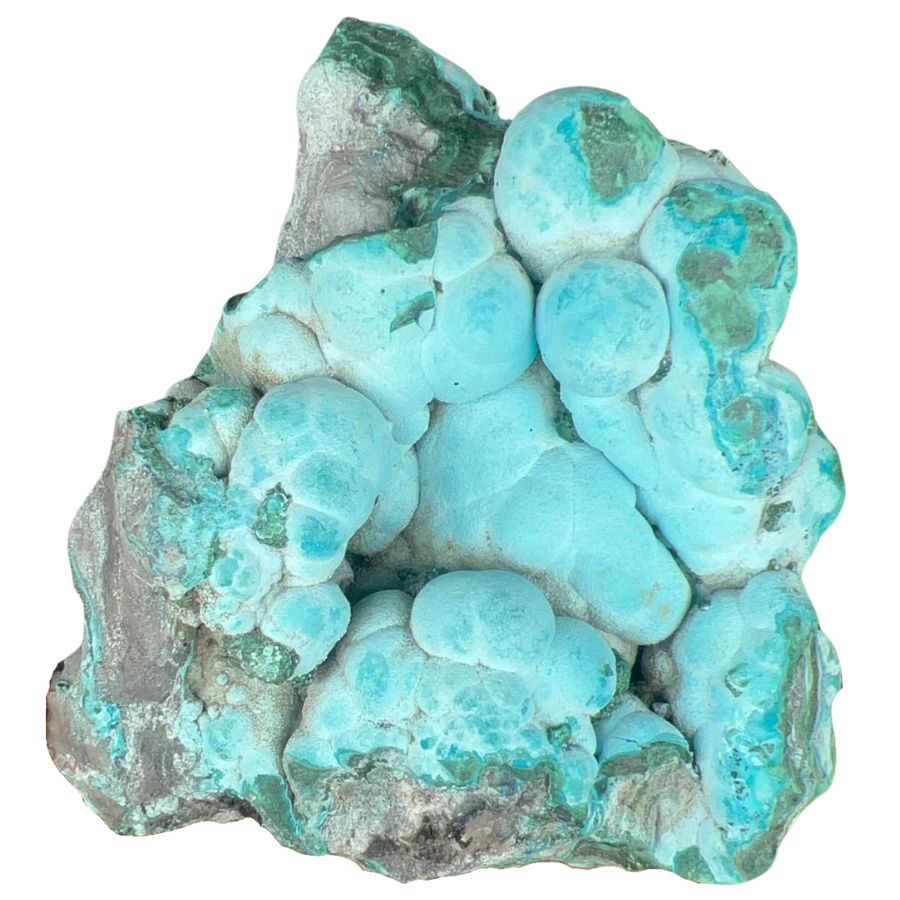
Chrysocolla is a captivating mineral known for its vibrant blue and green colors. This mineral is often used in jewelry making, adding a splash of color to necklaces, bracelets, and earrings.
In the past, chrysocolla was used for soldering gold due to its copper content. It’s also found in the crafting of small decorative items, like sculptures and ornamental pieces.
Chrysocolla’s striking appearance makes it a favorite among collectors and educators for showcasing mineral variety. This mineral is a great example of the diverse and colorful world of geology.
Fun Fact Cleopatra wore chrysocolla jewelery everywhere she traveled since it has the power to help violent people become more compassionate and accepting.
Where chrysocolla is found
Chrysocolla can be found in many places across the globe, including Chile, Arizona, Israel, and Peru.
How you can identify chrysocolla
Color
Chrysocolla is a beautiful blue-green color, often with mixed shades of turquoise and teal. It’s a vivid hue with a deep intensity ranging from light to dark.
Hardness
Chrysocolla has a hardness of 2.5-3.5 on the Mohs scale, making it a relatively soft stone. Therefore, it’s unsuitable for everyday wear as it may easily scratch, chip, or break if subjected to too much pressure or abrasion.
Clarity
Chrysocolla is generally an opaque mineral with a slightly translucent quality in thinner pieces, giving it a somewhat glassy to dull luster.
This opacity allows its vibrant blue and green colors to appear more saturated and vivid, enhancing its visual appeal in jewelry and decorative items.
Refractive index
Chrysocolla has a refractive index ranging from 1.48 to 1.58, which is relatively low compared to many other gemstones. This low index of refraction gives chrysocolla its unique blue-green color and soft luster.
Specific gravity
The specific gravity of chrysocolla is usually between 2.3 and 2.5, which is relatively low compared to other minerals. It’s considered a light mineral and can be easily identified by its low weight, allowing it to float in water.
Dumortierite – (Cu2-xAlx)H2-xSi2O5(OH)4·nH2O
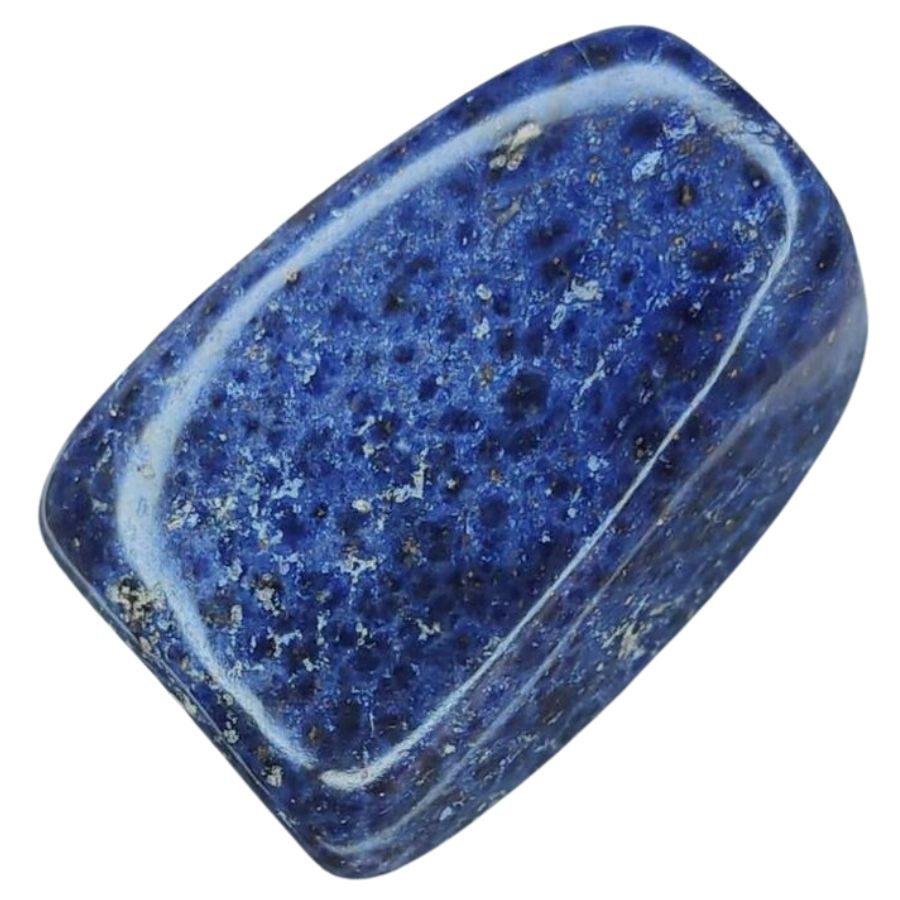
Dumortierite is a neat mineral that usually shows up in beautiful shades of blue, but it can also be pink, purple, or brown.
It’s really tough and is used to make porcelain that’s super strong and used for things like spark plugs and high-grade ceramics.
Dumortierite isn’t just for making things tough; it’s also cut into gems for jewelry, adding a unique touch with its cool colors. This mineral is great for students who are learning about different rocks because it has some unique properties and structures.
Even though it’s not as well-known as some other minerals, dumortierite has a bunch of uses in both science and everyday life.
Fun Fact
The stone is actually named after the paleontologist, Eugene Dumortier. Where dumortierite is found
Dumortierite can be found in many places, including Brazil, Canada, France, Germany, India, Italy, Madagascar, Namibia, Romania, and the United States.
How you can identify dumortierite
Color
Dumortierite is a blue to violet-blue mineral with a unique color. It often appears as a deep, cobalt blue with hints of violet and can sometimes have shades of gray or green.
Hardness
Dumortierite is a tough mineral, measuring 7 to 7.5 on the Mohs hardness scale. It’s harder than quartz but slightly softer than topaz. This mineral is also quite brittle and cannot be scratched easily.
Clarity
Dumortierite is typically an opaque mineral, meaning it doesn’t allow light to pass through, which highlights its deep, saturated colors.
Refractive index
Dumortierite has a refractive index of 1.608 to 1.629, making it slightly higher than most quartz minerals. It has a birefringence of 0.009 to 0.015, meaning that the two indices of refraction are somewhat different when viewed from different angles.
Specific gravity
The specific gravity of dumortierite is 3.2 to 3.4, considered quite heavy for a mineral. Its density is significantly higher than quartz, feldspar, and other common silicate minerals.
Glaucophane – Na2Mg3Al2Si8O22(OH)2
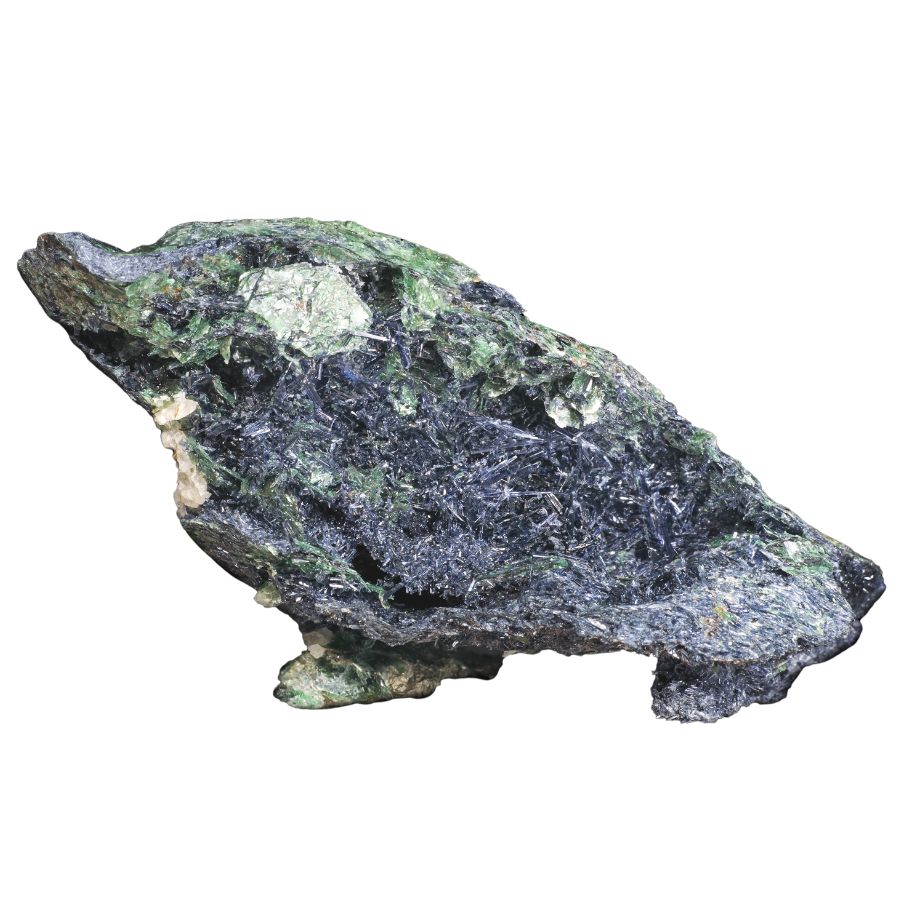
Glaucophane is a cool mineral that’s usually a neat blue or bluish-gray color. It’s part of a group of minerals that geologists call amphiboles and is often found in rocks that form under high pressures and low temperatures.
While glaucophane isn’t used for making jewelry or household items, it’s super important for scientists. They study it to learn about the conditions deep in the Earth where it forms.
Glaucophane helps geologists understand more about how mountains and other big landforms are made.
Fun Fact
Glaucophane was named after the Greek words glaukos (“bluish gray”) and phanēs (“appearance”). Where glaucophane is found
Glaucophane is found in blueschist facies metamorphic rocks. It’ i’s mainly found in high-pressure, low-temperature regional metamorphism areas, such as the Franciscan terrane of California and the Alpine-Himalayan belt.
It has also been found in Japan, New Zealand, Norway, Scotland, and Austria.
How you can identify glaucophane
Color
Glaucophane is a deep blue color with a hint of purple, often described as steel blue. It has a metallic sheen and can sometimes appear to have a grey tint, depending on how it’s lit.
Hardness
Glaucophane is a mineral with a hardness of 5-6 on the Mohs scale, making it quite hard and durable. It’s harder than copper, brass, and aluminum but softer than glass, quartz, and topaz.
Clarity
Glaucophane typically exhibits a translucent to opaque clarity, which means it allows some light to pass through but is mostly solid in appearance.
Refractive index
Glaucophane has a refractive index that ranges from 1.613 to 1.717, which is higher than average for most minerals and varies depending on wavelength and angle of incidence.
Specific gravity
The specific gravity of glaucophane is typically between 2.9 and 3.2, making it relatively heavy compared to other minerals.
Its density is also higher than average, contributing to its ability to sink quickly when placed in a liquid medium such as water or oil.
Lazulite – (Mg,Fe)Al2(PO4)2(OH)2
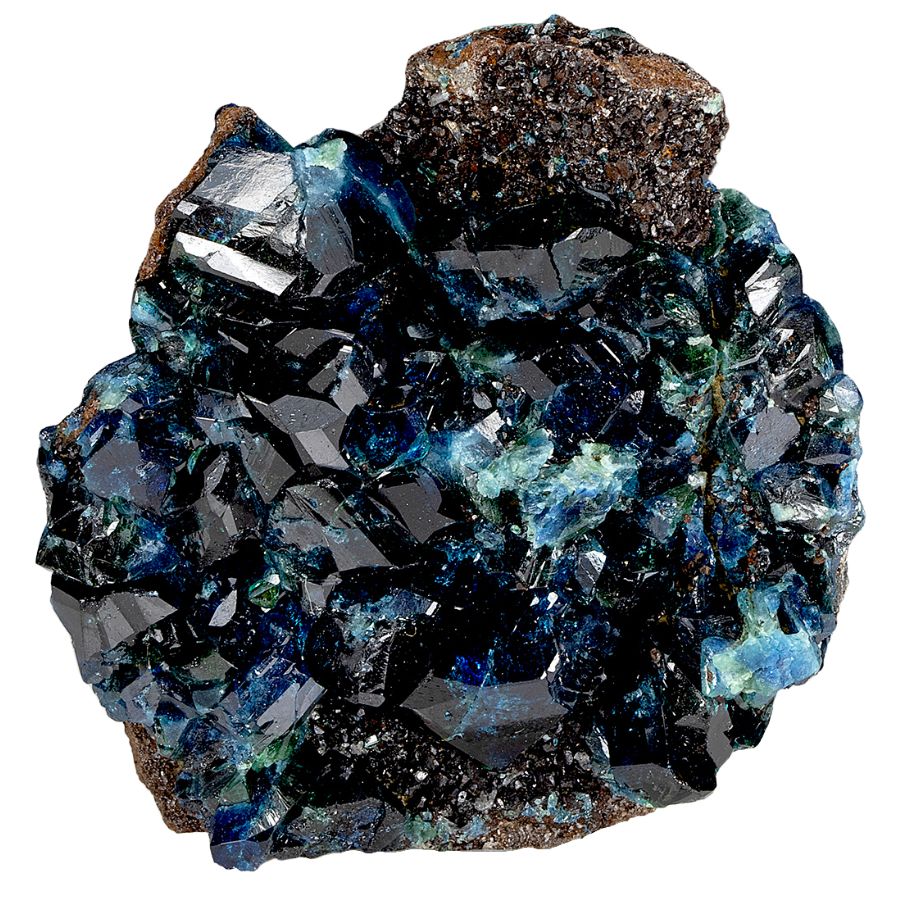
Lazulite is a mineral known for its deep blue to greenish-blue color that really stands out in rocks. It’s not just pretty; lazulite is used in ceramics and glass making because it can handle high temperatures.
Lazulite is often found in small, beautiful crystals that are a favorite among collectors and rock enthusiasts. Its striking color and usefulness in industrial processes make lazulite an interesting and valuable mineral.
While it might not be in everyday items like some other minerals, lazulite is super important for understanding different types of mineral formations.
Fun Fact Given that it's a sky blue color, this stone's name is derived from the Arabic word for heaven.
Where lazulite is found
Lazulite can be found in many countries, including the United States, Canada, Australia, India, Brazil, and Africa. It’s often found embedded in other minerals such as quartz or mica.
How you can identify lazulite
Color
Lazulite is a vivid blue stone that ranges from deep sapphire to bright sky blue. It has a unique sparkle and luster that is often described as a peacock feather’s shimmer!
Hardness
Lazulite is a relatively hard mineral with a Mohs hardness of 5.5-6. It’s harder than glass and can scratch most other minerals, but tougher minerals like quartz can still scratch it.
Clarity
Lazulite typically has a translucent to opaque clarity, meaning it allows some light to pass through but is mostly solid, which enhances its deep blue color.
Refractive index
The refractive index of lazulite is typically between 1.677 and 1.689, depending on the orientation of the crystal.
This value is relatively high compared to other minerals and indicates that lazulite has a strong birefringence, meaning that it splits light into two rays when passing through it.
Specific gravity
The specific gravity of lazulite is 3.3 to 3.6, making it a relatively heavy mineral. Its high density is due to its chemical composition and crystal structure. This makes lazulite heavier than most other minerals yet still light enough to float in water.
Sodalite – Na8Al6Si6O24Cl2
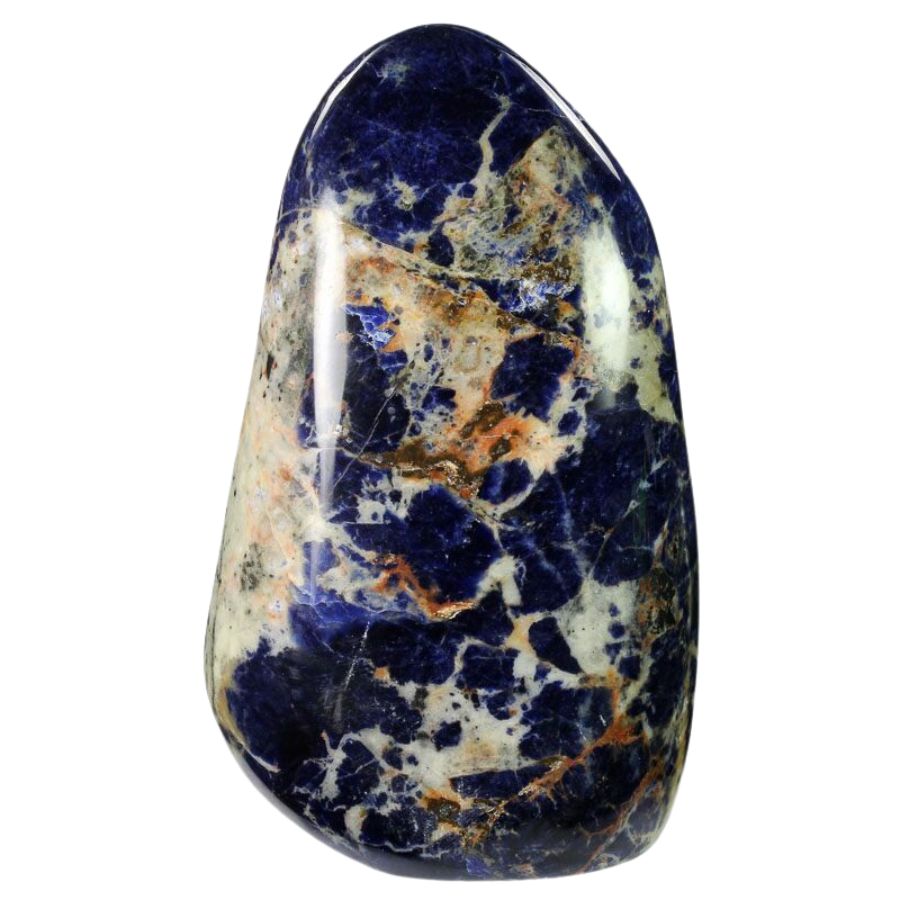
Sodalite is a neat rock that usually has a rich blue color, but it can also have white or gray mixed in. This rock isn’t just for looking at; it’s used in making things like glass and ceramics because it melts easily and is really strong.
Sodalite is also popular in jewelry and decorative items, giving a nice splash of color to whatever it’s part of. People who collect rocks really like sodalite because every piece is different, with its own pattern and shades.
Even though it’s not as well known as some other minerals, sodalite has a bunch of uses that make it pretty cool. Its bold color and versatility make it a favorite for both practical uses and for anyone who likes to add a bit of color to their collection.
Fun Fact During Princess Margaret of England's official visit to Bancroft, Canada in the 1800s, sodalite rose to fame. The princess fell in love with the rock and used it as "Marlborough House's" interior decor. Because of this, sodalite from that region of Canada is occasionally referred to as Princess Blue.
Where sodalite is found
Sodalite can be found in various locations, including Canada, Brazil, India, Namibia, and Russia. It’s also commonly found in the United States in Maine and North Carolina.
How you can identify sodalite
Color
Sodalite is a dark blue gemstone with white streaks and patches of grey. It has a deep, intense color ranging from navy to royal blue and sometimes even a greenish hue.
Hardness
Sodalite is a hardness of 5.5 to 6 on the Mohs Scale, making it a relatively hard gemstone. It’s considered an excellent gemstone for jewelry use due to its durability and toughness, perfect for everyday wear and tear without any damage.
Its hardness also makes it ideal for carving, engraving, and other lapidary uses.
Clarity
Sodalite is typically opaque, which means no light can pass through.
Refractive index
Sodalite has a refractive index of approximately 1.48-1.51, which is considered relatively low compared to other gemstones.
It has a birefringence of 0.009-0.014. Its dispersion is also low at 0.016, and its pleochroism is weak, meaning it appears blue regardless of which angle it’s viewed from.
Specific gravity
Sodalite has a specific gravity of 2.45-2.55, making it slightly heavier than average for minerals in the feldspathoid group. It’s denser than most silicate minerals and has higher specific gravity than quartz, calcite, and gypsum

